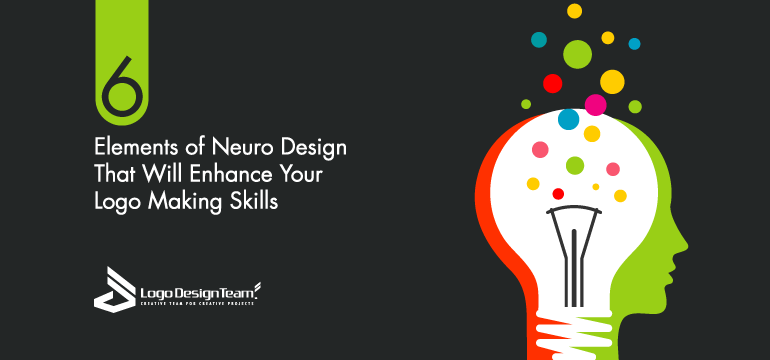Neuromarketing is the recent buzz in the logo design industry. Yes, the entire world is bent on making an impact on their target audience using the new wave in designing – neuro design.
But what is neuro design? Why is everybody talking about it?
Well, let’s take a deep dive here.
We all know that to grab the attention of your target people, you need to craft designs that triggers their emotion and teases out their reactions.
Neuro Design is the concept of creating logos applying mind sciences such as neuroscience. It can be identified as a new technical tool that helps designers understand how our brains work while processing information from a design. This way logo creators can develop a logo by extending their intuitive skills.
Logo design – How The Brain Processes It
When a viewer sees a logo, his brain continuously works at the background before it delivers information to the viewer’s eyes. Neuroscientists have long been researching how the brain perceives and recognizes a logo design. Also, they have been trying to understand how it impacts decision making.
Neuroscience says that when a human mind sees a logo, it processes the visual elements. The first element that catches the visual cortex is the color; then it proceeds towards the form then finally the motion of the design influences the mind. Our brain then deciphers the whole logo meaning. Therefore, when designers create logos embracing neuro-design principles, the representation becomes more convincing. Neuro design insights describe that every design triggers an emotional response.
Take a look at the 6 elements of neuro design that will enhance your logo making skills:
1. Implement Patterns in Logo Design
Patterns in designs have always played a significant role in influencing our brains. According to Neuroscience, the human mind is lazy and looks for shortcuts to process any information. As patterns recognition requires less energy while preparing a situation and taking a decision, needless to say, brains have an innate preference for patterns. So when we come across any design, our brain tends to identify things and label them through the pattern.
You can use patterns into a logo design in multiple ways – geometric pattern or grid design, symmetry and regular proportions or golden ratio. Although there’s no hard and fast rule to use patterns, yet using these designing elements can appeal to your audience instantly. Take a look at an interesting example – The Twitter Logo created by using two overlapping circles.
Image: Twitter Logo
Image Source: https://logogeek.uk/logo-design/neuro-design/
2. Propositional Density Influences Human Mind
Logo Design ought to be simple yet meaningful. But did you know that too much simplicity can backfire sometimes? Mind sciences have an exciting story to reveal-when a design is too plain; our brain labels it as dull and unimpressive.
It’s undoubtedly a challenge for every logo designer- how to craft a design so that your audience can feel a particular emotion and perform a specific action?
Introduce ‘propositional density,’ neuroscientists say propositional density is the relationship between the elements of design and the meaning they convey. This means in a logo every element- the lines, shapes, colors, texts all carry a specific sense. Every aspect of your design is communicating something to the audience. Combinations of elements convey additional information in the way the components interact with each other. Therefore, propositional density is the amount of information expressed by a component or design per unit element.
Using proposition density in design allows the artist to measure how much meaning your elements, their combination and your overall design convey to your audience. The higher the propositional density in your design, the more you’ll have communicated to your viewers. Your audience will find your logo and more likely they’ll remember the design and your message. Apple logo is the best example for this.
3. Establish a Lasting Effect with Curves and Tapered Shapes
Curves and tapered shapes are said to have a lasting effect on the viewers’ mind. Research shows that the audience prefers curves and cusps compared to angular or spiky structures. Curved shapes have smoother edges than angular ones. This signifies how shapes like curves and cusps have an unusual effect on our mind. To make an impact on your target audience, you can feature your logo design with curvy shapes, cusps or tapered shapes.
4. Use of Right Colors Evoke Emotion
As a designer, it’s well known to us that using the right colors are crucial in giving a deeper meaning to a design. But do you understand how colors affect a viewer’s mind? Cognitive scientists find that the cells in the brain process colors from every local area of an image.
Neuroscience describes that our mind interprets the edge between two colors and uses it to figure out what the neighboring colors should be. The brain deciphers that each color has a specific meaning, so it’s highly advantageous to use the color that matches your target audience’s emotion.
Research reveals that brain processes warmer colors more easily than cool ones.
5. Left Visual Fields Pique Our Curiosity
Designs that have images at the left and texts on the right are considered to be the most aesthetically pleasing ones. According to neuroscience, when we see something, the left visual field is delivered to the visual cortex first and then the right part of our brain decodes visual patterns. The information we see on the right reaches our left cortex which is the analytical part of our brain.
This tendency of paying more attention to visuals on the left side of our visual field is termed as pseudoneglect. This proves that our brain is better noticing things at the left side, so if you want an image in your design to get seen, consider putting it to the left of your design. See how successful logo designers like Lead Liaison put an icon or graphical element on the left side and text on the right side of the design.
Image – Lead Liaison
Image Source: https://www.leadliaison.com/
6. Create Visually Prominent Elements
Our brains recognize those elements that are seemingly prominent from their surroundings. So while designing a logo, it would bring great advantage if we give importance to specific visual components and make them stand out from others. Neuroscientists define this approach of creating visually prominent elements as ‘visual saliency.’
What is the best way of boosting the visual saliency of a logo?
Expert logo designers are of the view that improving the use of brightness, color, contrast, patterns, and depth can enhance the visual saliency of a logo. For example, you can create a logo that uses contrasting colors, or you can make logos that have depth. Human mind processes such as designing information quickly and then they can memorize it for long.
Another way to improve visual saliency and captivate audience attention- you can apply motion into the logo. That is to say, create animated logos and grab the attention of the target audience instantly. Undeniably, viewers are sure to get attracted to such a unique and fantastic presentation.
Concluding Thoughts
Neuro design principles help the logo designers to understand which artful element has more appeal on the subconscious mind of a viewer. Now you know that mind sciences have a pivotal role in logo design and it provides a more strategic approach to your logo designs. With the increasing competition in the market and technology development leveraging neuro design principles may add a feather to your logo design skills.
A creative flow that hooks your potential consumers to your brand is hard to find. Visit Logo Design Team to know more how you can carve magic.




